|
Narrow Gauge |
 |
The Amerton Railway's 2ft gauge Bagnall 0-4-0ST 1491 Isabel starts out on its journey along the railway's one mile circuit with the 11:30 departure, the first train of the day, on 10 July 2022. Having just passed the oak tree on the straight section of track north of the station, it is now passing the picturesque Amerton Pond. |
|
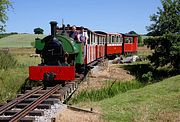 |
Bagnall 0-4-0ST 1491 Isabel crosses over Amerton Brook with the Amerton Railway's 11:30 train on Sunday 10 July 2022. Isabel was built in 1897 for the Cliffe Hill Granite Company of Markfield, Leicestershire. Withdrawn in 1946, the loco was cosmetically restored and displayed on a plinth in Victoria Park, Stafford. In the 1980s the Stafford Narrow Gauge Railway Society Ltd was formed to bring the loco back to life, and after an extensive restoration, the loco arrived at the Amerton Railway in 1991. A trio of Amerton Farm's sheep can be seen in the background. |
|
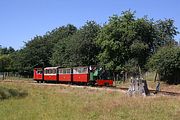 |
The 11:50 Amerton Railway departure approaches Stump Junction on Sunday 10 July 2022, in the capable hands of Bagnall 0-4-0ST 1491 Isabel. The junction point levers, and the eponymous stump can be seen on the right! |
|
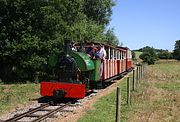 |
Bagnall 0-4-0ST 1491 Isabel is pictured on the approach to Amerton station, after completing a circuit of the line with the 11:50 train on 10 July 2022. The construction of the 2ft gauge Amerton Railway started in 1990, and opened two years later, initially with just a short section of track. The complete one mile circuit opened in 2001. |
|
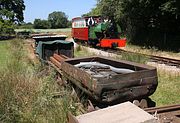 |
Bagnall 0-4-0ST 1491 Isabel passes a motley collection of rolling stock on the Amerton Railway's drift mine siding on 10 July 2022. The train is the 12:10 departure on what was a completely sunny and very hot day. Amerton Farm's sheep wander at will all over the railway, but the hot weather meant that a lot of them were sheltering in the shade of the tree on the left. |
|
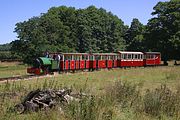 |
Bagnall 0-4-0ST 1491 Isabel rounds the curve on the approach to the Amerton Brook bridge with the 12:10 train on 10 July 2022. The Amerton Railway offers endless photographic possibilities, as the line weaves through the trees and through the field on its one mile circular route. |
|
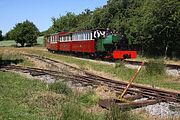 |
The 12:30 Amerton Railway departure passes the industrial railway sidings on 10 July 2022, as Bagnall 0-4-0ST 1491 Isabel does another circuit of the line. Despite the perfect weather, the first trains of the day were only lightly loaded, but perhaps that had something to do with the Wimbledon Men's Final taking place later in the day! |
|
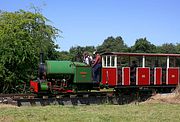 |
The Amerton Railway's Bagnall 0-4-0ST 1491 Isabel crosses over the Amerton Brook on 10 July 2022 with the 12:30 train. There is quite an overhang at the back of the loco. It almost looks like it should have been an 0-4-2ST! |
|
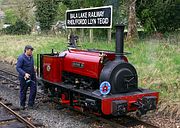 |
Hunslet 0-4-0ST 680 George B receives some attention at Bala on 1 May 2022, after arriving with the 15:10 train from Llanuwchllyn. The loco, which was built in 1898, worked in the Dinorwic Slate Quarry until 1965. After initially being stored at the Dowty Railway Preservation Society, Ashchurch, it arrived at the Bala Lake Railway in 2017 for a full restoration. |
|
 |
Bala Lake Railway Hunslet 0-4-0ST 779 Holy War waits at Bala station on 31 May 2012. It will shortly be working the 15:00 service to Llanuwchllyn. The original Great Western Railway footbridge looks slightly out of place, now the track has downsized somewhat! The original station opened in 1934 as Bala (Llyn Tegid). |
|
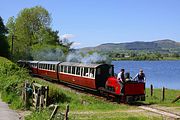 |
With Bala Lake looking especially blue under a sparkling clear sky, 0-4-0ST 780 Alice approaches Pentrepiod Halt on 30 May 2016 with the 11:00 Llanuwchllyn to Bala service. The Bala Lake Railway was staging their 'Festival of Transport', with various vintage vehicles on display at Llanuwchllyn, along with an enhanced train service. The crossing in the foreground gives access to a lakeside campsite. |
|
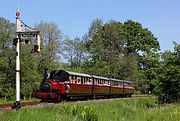 |
Hunslet 0-4-0ST 780 Alice approaches the unusual bracket signal at Llangower on 30 May 2016, as it works the 11:40 Bala to Llanuwchllyn service, during the Bala Lake Railway's 'Festival of Transport'. This loco, along with the several others on the line, spent its working life at the Dinorwic slate quarry. |
|
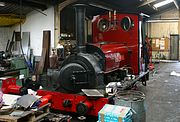 |
Surrounded by all the general clutter of a railway workshop, including, surprisingly a small model of itself, 1903 built Hunslet 0-4-0ST 822 Maid Marian reposes in Llanuwchllyn shed at the Bala Lake Railway on 31 May 2012. The loco spent its working life at the nearby Dinorwic slate mine. |
|
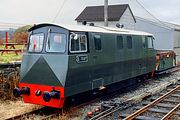 |
The Bala Lake Railway's 1973 built Severn Lamb D1087 Merionnydd, pictured at Llanuwchllyn on 9 August 2002. This loco has carried numerous liveries during its career. This rather drab colour scheme had been replaced by a bright blue paint job when I saw it parked in the same position ten years later. |
|
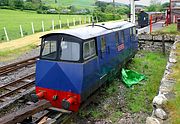 |
The Bala Lake Railway's interpretation of a Class 52 'Western'! The 1973 built Severn Lamb D1087 Merionnydd (works number 22) is pictured at Llanuwchllyn on 31 May 2012. This is definitely not BR blue, and the loco has subsequently repainted into the much more typical Western livery of maroon with small yellow panel. It had previously appeared in BR blue with full yellow ends, and also a slightly drab grey-green colour scheme. |
|
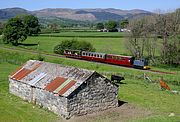 |
Baguley Drewry 0-4-0 780 Bob Davies passes Dolfawr on 30 May 2016 with the 10:15 Llanuwchllyn to Bala service. The southern section of the Bala Lake Railway has some superb photographic vantage points. This particular spot with the rustic barn, complete with rusty corrugated iron roof repairs is especially attractive. the whole scene is enhanced by some unexpected Bank Holiday Monday sunshine. |
|
 |
Baguley Drewry 0-4-0 780 Bob Davies passes the diminutive Pentrepiod Halt on 30 May 2016 with the 10:50 Bala to Llanuwchllyn service. The loco was built in 1983 for the Royal Navy, and was used at Fishguard, before being purchased by Pete Briddon's Yorkshire Engine Company, and then moving to the Bala Lake Railway. |
|
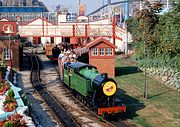 |
The Blackpool Pleasure Beach Express Railway's 4-6-4T steam outline diesel loco 4473 Carol Jean starts out on another circuit of the line on 5 September 1999. This and 4-6-2 4472 Mary Louise were the railway's original locomotives, both built in 1933. In the background is the line's other steam outline locomotive, 4-6-2 6200 Princess Royal. Leaning out of the cab is the line's regular driver (since retired), Teddy Askey MBE, whose diminutive stature was ideally suited to the confined space within the 21 inch gauge loco's cabs. The floral display on the left looks conventional, but I'm not sure about the cabbages and onions on the right! I don't normally take pictures of locos with faces on the front, but bearing in mind this line's location, it does seem appropriate! |
|
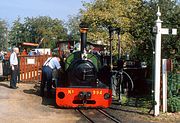 |
The driver of Hunslet 0-4-0ST 994 George Sholto does some last minute oiling, prior to working another trip on the 2 ft gauge Nursery Railway at Bressingham on 24 September 2000. The loco was built in 1909 for the Penrhyn Quarry Railway. Bressingham Gardens was established by the late Alan Bloom in 1946, and in addition to standard gauge railway locomotives, includes this 2ft gauge line, two other miniature lines, and numerous other exhibits, including traction engines (one can be seen in the background here). |
|
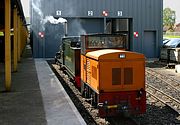 |
The Bure Valley Railway's 0-4-0 diesel loco No.4 stands in front of the shed at Aylsham on 30 May 2014, while steam loco No.7 Spitfire simmers away behind. No.4 was built by Hudson Hunslet in 1954, as a two foot gauge locomotive. It is employed on the Bure Valley as the Aylsham pilot and general shunter. |
|
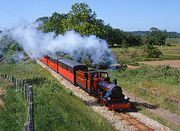 |
Bure Valley Railway 2-6-2 No.6 Blickling Hall passes Brampton on 1 June 1997 with the 15:30 Aylsham to Wroxham service. This loco was built in 1994, and is a half size replica of the 2' 6" gauge Indian ZB class. The initial design was not a success, and the loco has been rebuilt since this picture was taken, with various modifications improving its performance enormously. |
|
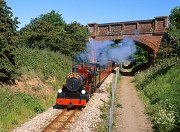 |
Bure Valley Railway 2-6-2 Winson Engineering built 6 Blickling Hall passes Coltishall on 1 June 1997 with the final train of the day, the 16:35 Wroxham to Aylsham service. This 15" gauge line is laid on the trackbed of the Midland and Great Northern Railway line which closed in the 1950s. This explains the standard gauge overbridge seen in this view. A popular cycle track parallels the line for much of its length, which does tend to limit the number of photographic vantage points. |
|
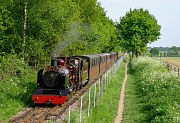 |
Plenty of signs of spring on the Bure Valley Railway on 12 May 2008, as 2-6-2 Winson Engineering built 6 Blickling Hall approaches Belaugh Green Crossing with the 16:35 Wroxham to Aylsham service. It is obviously a little early in the season for walkers or cyclists to be using the adjacent footpath, as not one person passed while I was waiting for this train. |
|
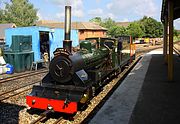 |
Complete with inelegant chimney extension, Bure Valley Railway 2-6-2 No.7 Spitfire has steam up, as it stands in front of the shed at Aylsham on 30 May 2014 in the company of 0-4-0 diesel No.4. Spitfire was built by Winson Engineering in 1994. |
|
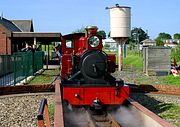 |
Bure Valley Railway 2-6-4T No.9 Mark Timothy slowly moves onto the turntable at Wroxham on 30 May 2014, after arriving with the 15:30 service from Aylsham. Just visible on the right is the Norwich to Sheringham standard gauge line, now branded as the 'Bittern Line'. |
|
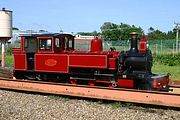 |
Bure Valley Railway 2-6-4T No.9 Mark Timothy pictured on the turntable at Wroxham on 30 May 2014, after arriving with the 15:30 service from Aylsham. The loco was built by Winson Engineering in 1999. She rebuilt by Alan Keef Limited to a Leek and Manifold outline in 2003 |
|
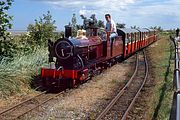 |
1963 Guest Engineering built 2-4-2 Siân is pictured next to the dunes on the Cleethorpes Coast Light Railway on 27 July 1997. Siân spent the first twenty years of her life on the Fairbourne Railway, moving to pastures new when that line took the dramatic step of regauging from 15" to 12¼". The loco has also spent time on the Ravenglass & Eskdale Railway. |
|
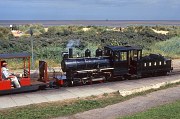 |
Fairbourne Railway built 2-6-2 Sandy River & Rangeley Lakes No.24 waits next to the dunes on the Cleethorpes Coast Light Railway on 27 July 1997. The Spurn Head lighthouse can just be seen in the distance on the horizon above the loco's chimney, on the other side of the mouth of the River Humber. |
|
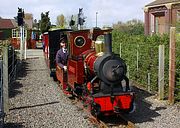 |
The driver of Cleethorpes Coast Light Railway 0-4-0 Mountaineer seems happy enough, as the 13:35 Kingsway to Humberston North Sea Lane service leaves Cleethorpes Lakeside station on 19 April 2014. The loco was built by Wilhelm Van den Heiden in 1972. |
|
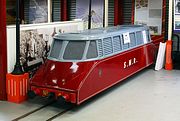 |
Former Sutton Miniature Railway railcar No.4 is pictured in the Cleethorpes Coast Light Railway museum at Cleethorpes Lakeside station on 19 April 2014. While a lot of miniature railway diesel locos and railcars only have a passing resemblance to their main line equivalents, this is a fairly passable representation of a streamlined GWR diesel railcar. |
|
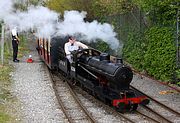 |
Cleethorpes Coast Light Railway 2-8-0 6284 arrives at Cleethorpes Lakeside station on 19 April 2014 with the 15:15 Kingsway to Humberston North Sea Lane service. The loco is based on the Robinson designed heavy freight loco, originally introduced by the Great Central Railway in 1911. This particular loco is slightly more modern, having been built in 2009! |
|
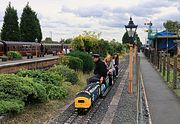 |
I have photographed 37401 Mary Queen of Scots many times, but prior to this it has always been a lot larger! The Coalyard Miniature Railway's 7¼ inch gauge version is pictured running along the 357 metre long line at Kidderminster on 25 September 2022. The Severn Valley Railway's Kidderminster Town station is on the left. |
|
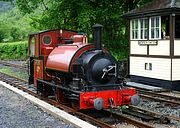 |
0-4-2ST 3 Sir Haydn back home on the Corris Railway on 3 June 2012. Although unable to run as its boiler certificate has expired, the former Corris Railway locomotive is a star attraction on the line, which it left in 1951 for a second life on the Talyllyn Railway. Although in need of much work, the Talyllyn obviously got a bargain, as it only cost them £25! That was cheap even in the 1950s. It is pictured standing beside the reconstructed Maespoeth Junction signal box. |
|
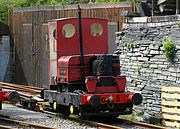 |
The Corris Railway's diminutive Simplex 4wDM No.5 Alan Meaden, pictured in the sunshine at Maespoeth on 30 April 2022. The loco was built in 1965, and worked for Staveley Lime Products, Hindlow, until secured for preservation on 1974. Apparently the loco is unpopular due to its inertia starting system, that doesn't always work! |
|
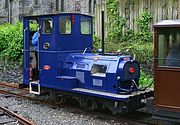 |
Corris Railway Ruston & Hornsby 0-4-0 No.6 propels its train into Corris station on 3 June 2012. Holy Trinity church can be seen in the background, the railway following the eastern edge of the graveyard as it enters the station from the Maespoeth direction. This 1966 built locomotive was originally 2' 6" gauge, and was regauged on arrival at Corris to 2' 3". |
|
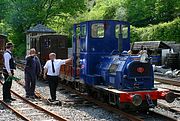 |
Conversation piece at Maespoeth on 29 May 2016, during the Corris Railway's Gala Day. The crew of Ruston & Hornsby 0-4-0 No.6 discuss some operational point with the signalman, before working the late running 14:08 Maespoeth to Corris, conveying the two wagons that had previously worked down on the gravity train, plus a brake van. |
|
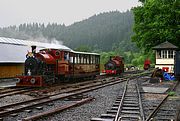 |
Corris Railway 0-4-2ST No.7 waits in the rain at Maespoeth to form the next train back to Corris on 3 June 2012. Directly behind it is one of the line's original locomotives - No. 3 Sir Haydn, which is on loan from the Talyllyn Railway, its adopted home since the 1950s. |
|
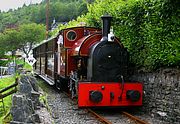 |
Winson Engineering built 0-4-2ST No.7 arrives at Corris on 29 May 2016 with the 13:40 Maespoeth to Corris service, during the Corris Railway's Gala Day. As can be seen, much use is made of the local slate for lineside walls. |
|
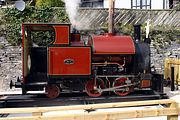 |
Corris Railway 0-4-2ST No.7 stands on the new traverser at Corris station on 30 April 2022. The traverser, which was constructed by Statfold Engineering, Tamworth, enables locos to run round in the very cramped station site. It is operated manually, with two people pushing on removable posts at each end of the table. |
|
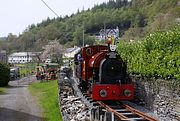 |
Corris Railway 0-4-2ST No.7 approaches Corris on 30 April 2022 with the 'Machynlleth Comedy Festival' special, returning from Maespoeth. The line bends to the left just behind the train, passing in front of the row of white houses. |
|
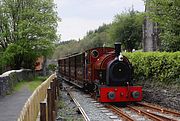 |
Corris Railway 0-4-2ST No.7 arrives at Corris station with empty stock from Maespoeth, prior to working the first passenger train of the day on 6 May 2024. The railway here squeezes between the farm access road on the left, and the church on the right. |
|
 |
Corris Railway 0-4-2ST No.7 runs round its train at Maespoeth on 6 May 2024. It is passing the 1878 built engine shed, which is still serving its original purpose, 146 years later. The large hole in the back of the cab is to allow the fire to be cleaned using long fire irons. |
|
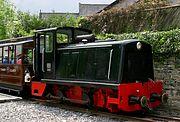 |
In 2015 the Corris Railway acquired this Orenstein & Koppel 0-4-0 diesel hydraulic locomotive from Mauterndorf in Austria. 25721 was built in 1957 for a construction company in Vienna. A slight change of gauge (from 760 mm to 687 mm) was required before it could be used in Wales. It is pictured here at Corris on 29 May 2016. |
|
 |
The Corris Railway's diminutive Clayton 0-4-0 battery electric locomotive No.9 Aberllefenni is pictured inside the carriage shed at Maespoeth on 29 May 2016. The loco was built by Clayton in 1974 for the Aberllefenni Slate Quarry. |
|
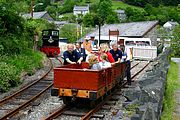 |
One of the highlights of the Corris Railway's Gala on 29 May 2016 was the working of the gravity train. Here, the first of the two departures (13:25) is pushed out of Corris station. In the background is the line's recently acquired Orenstein & Koppel 0-4-0 diesel hydraulic locomotive 25721. |
|
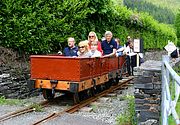 |
The Corris Railway's 13:25 gravity train finally begins to roll after being pushed out of Corris station on 29 May 2016, during the line's Gala Day. At present the line runs for approximately one mile down the Afon Dulas Valley from Corris to Maespoeth. |
|
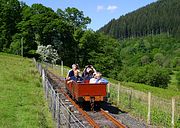 |
The 15:50 Corris to Maespoeth gravity train approaches its destination on 29 May 2016, during the Corris Railway's Gala Day. Note the brakesman controlling the descent. The very photogenic location and some unexpected, and very untypical, warm sunny bank holiday weather makes for an interesting picture. |
|
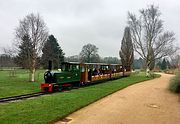 |
Cotswold Wildlife Park Railway No.4 Bella passes the rhino paddock, whilst on another circuit of the park on 27 December 2019. The two foot gauge 0-4-0T steam outline diesel loco was built by Alan Keef in 2003. The Cotswold Wildlife Park occupies the grounds of Bradwell Grove Manor House, an early nineteenth century country estate house, near Burford. |
|
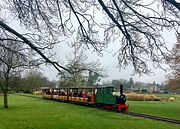 |
Bradwell Grove Manor House is prominent in the background of this view of Cotswold Wildlife Park Railway No.4 Bella, pictured doing another circuit of the park's railway on 27 December 2019. The house was built in 1804 by William Hervey. It was designed by William Atkinson and built in the Gothic style by local builder Richard Pace. |
|
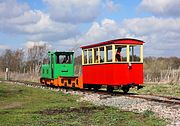 |
Schöma 0-4-0 5129 was in action at the Crowle Peatland Railway over the 2023 Easter Weekend, giving rides along the line's 530 yard long track. It seen here propelling slave unit 5131 and the railway's single coach, on the approach to the line's headquarters on 8 April 2023. The undulating nature of the track is a perfect recreation of normal peat railway practice! |
|
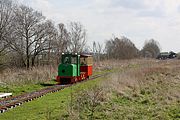 |
Virtually the whole length of the Crowle Peatland Railway's line can be seen in this view of Schöma 0-4-0 5129 nearing the northern limit of the line on 8 April 2023. The railway's shed can be seen in the background. |
|
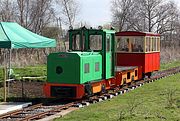 |
Schöma 0-4-0 5129 and slave unit 5131 stand at the 'station' at the northern end of the Crowle Peatland Railway on 8 April 2023, having just arrived with another train load of visitors, during the line's Easter Open Day. |
|
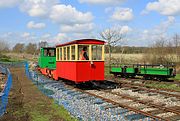 |
Schöma 0-4-0 5129 arrives back at the Crowle Peatland Railway's headquarters on 8 April 2023, having just completed another trip along the railway's 530 yard line, during the Easter Open Day. On the right is Wickham Type 17A Trolley No.4091 and its unpowered trailer. |
|
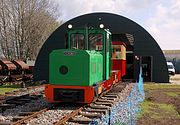 |
Schöma 0-4-0 5129 emerges from the Crowle Peatland Railway's shed on 8 April 2023 with another demonstration train, during the line's Easter Open Day. On the left are three tipper wagons, which are on loan from the Isle of Man Railway. |
|
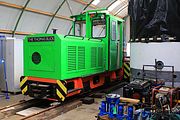 |
Looking very smart in its light green paintwork, Schöma 0-4-0 5220 The Thomas Buck stands inside the Crowle Peatland Railway's shed on 8 April 2023. Unlike the line's other two Schöma locos, this one retains its original 5 Cylinder Deutz engine. On the right is former Lisbon tram 711. |
|
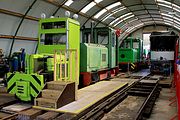 |
A line up of Crowle Peatland Railway motive power, inside the railway's shed on 8 April 2023. From left to right: Motor Rail 0-4-0 40hp 40s302 Little Peat, Schöma 0-4-0 5130, Schöma 0-4-0 5220 The Thomas Buck, and former Lisbon Tram 711. |
|
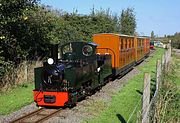 |
The Evesham Vale Light Railway's 1970 built Severn Lamb 0-6-2 3 Dougal runs through the orchard (note the fallen apples on the grass and ballast), just after starting out from the line's headquarters (Twyford station) with the first train of the day, the 10:30 departure, on 2 October 2016. In the background, one of the line's diesel locos, 452280 Cromwell can be seen. |
|
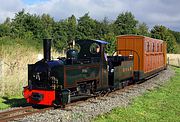 |
Severn Lamb 0-6-2 3 Dougal rounds the balloon loop at the southern end of the Evesham Vale Light Railway on 2 October 2016, with the 11:00 departure from Twyford station. This was the second train of the day. After a sunny start, there were now some large clouds building up, as can be seen in the background. |
|
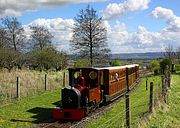 |
The Evesham Vale Light Railway's 0-4-2T 300 Monty heads back towards Twyford station with the 14:00 service on 1 April 2017. Just behind the train is the point where the balloon loop starts. This view is looking south east, with the Vale of Evesham in the background, and the Cotswold Hills in the far distance. |
|
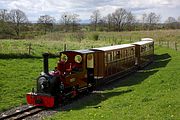 |
The Evesham Vale Light Railway's 0-4-2T 300 Monty negotiates the railway's circuit on 1 April 2017 with the 14:00 departure. Although taken from the shady side, I particularly like the composition of this picture, with the Cotswold Hills in the background. |
|
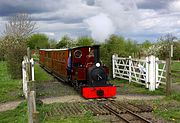 |
The Evesham Vale Light Railway's 0-4-2T 300 Monty gets under way with the 14:30 departure on 1 April 2017, unfortunately just as the sun started to disappear. However, as can be seen from the clouds in the background, it would later get an awful lot darker! Monty was built by the Exmoor Steam Railway in 1996. |
|
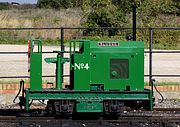 |
It seems to be something of a tradition that the smallest diesel locos on many narrow gauge and miniature railways have less than flattering names. The Evesham Vale Light Railway's contribution to this genre is 1955 built Lister 4wDM JGF4 Sludge. It is seen here basking in the autumnal sunshine on 2 October 2016. |
|
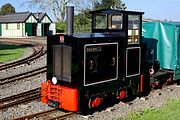 |
1984 built Ruston & Hornsby 4wDH 452280 Cromwell stands in the sunshine at the Evesham Vale Light Railway on 2 October 2016. The railway's two road engine shed can be seen in the background. The loco had previously been resident at Littlecote House, and Markeaton Park. It was regauged and converted to hydraulic transmission by Alan Keef. |
|
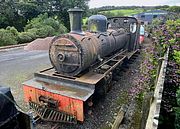 |
Former South African Railways Class NG15 2-8-2 No.2685 looks in a very sorry state, when pictured at the Exmoor Steam Railway's site at Bratton Fleming on 16 September 2025. The loco was built by Societe Anglo Franco Belge in 1955. |
|
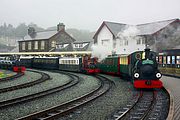 |
A line up of locomotives in the rain at Porthmadog on 1 May 2022. On the right is the Ffestiniog Railway's 2-4-0ST+T Blanche. In the centre is the Richmond Light Railway's Hunslet 0-4-0ST Sybil. On the left is Hunslet open cab 0-4-0ST Elin, also from the Richmond Light Railway, with the Ffestiniog Hunslet 0-4-0ST Britomart partly visible behind. |
|
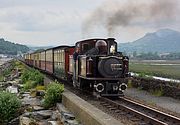 |
In typically gloomy Welsh weather, Ffestiniog Railway 0-4-4-0T 10 Merddin Emrys crosses the Cob with the 13:35 Porthmadog to Blaenau Ffestiniog service on 2 June 2012. This mile long embankment predates the railway, being built in 1811 for land reclamation purposes. |
|
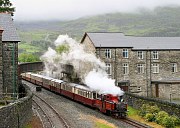 |
Ffestiniog Railway Fairlie 12 David Lloyd George leaves Blaenau Ffestiniog with the 11:45 train to Porthmadog on 4 June 2005. It had just about stopped raining, but the clouds are still enveloping the mountains in the background. Note the standard gauge line to Llandudno Junction in the foreground. David Lloyd George was built at the railway's Boston Lodge works in 1992, and is the most powerful double Fairlie locomotive in the world. |
|
 |
Ffestiniog Railway Fairlie 0-4-4-0T 12 David Lloyd George stands in the pouring rain at Porthmadog station on 20 October 2014, prior to working the 10:10 service to Blaenau Ffestiniog. Despite getting the camera soaked during the brief time that it took to take this picture, the result is worth it, as it just typifies Welsh weather! |
|
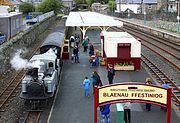 |
Ffestiniog Railway Fairlie 0-4-4-0T 12 David Lloyd George stands at Blaenau Ffestiniog station on 20 October 2014, after having just arrived with the 10:10 service from Porthmadog. Even if the location wasn't already easily identifiable, the sign leaves little doubt! |
|
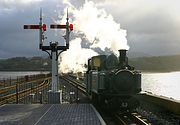 |
Ffestiniog Railway Fairlie 0-4-4-0T 12 David Lloyd George arrives at Porthmadog station on 21 October 2014, after having just crossed the Cob from Boston Lodge. It would shortly be working the 10:10 service to Blaenau Ffestiniog. I particularly like the way the exhaust stands out against the dark clouds, and the backlighting of the red semaphore signal spectacles. |
|
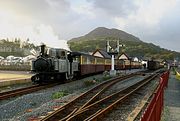 |
Ffestiniog Railway Fairlie 0-4-4-0T 12 David Lloyd George sets off from Porthmadog station on 21 October 2014 with empty coaching stock for Boston Lodge, at the end of the day's services. The 863 feet high peak of Moel-y-Gest dominates the background. |
|
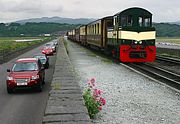 |
Two modes of transport travel along the Cob at Porthmadog on 2 June 2012. The Ffestiniog Railway's 0-6-0 diesel locomotive Criccieth Castle draws the 12:55 train from Caernarfon into Porthmadog station, whilst motorists travel at roughly the same sedate speed as they arrive at the town. The Welsh Highland Railway's Garratt locomotive No. 87 is on the rear of the train, which must perform this reversal in order to enter the station. The single Valerian plant growing from the wall in the foreground adds some colour to the scene. |
|
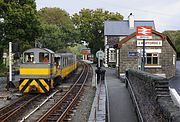 |
Ffestiniog Railway 0-6-0 diesel hydraulic loco Harlech Castle pulls away from a brief stop at Minffordd station on 19 October 2014, with an engineering train heading for the nearby Minffordd Yard. Harlech Castle was built by Baguley-Drewry Ltd in 1983. It had originally been destined for use in Mozambique. As delivered it fouled the Ffestiniog loading gauge, and was only able to be used in Minffordd Yard. After being fitted with a reduced height cab, it was able to be used all along the line, as a civil engineer's loco. |
|
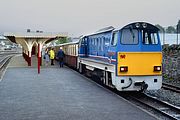 |
Under a typically grey North Wales sky, Funkey B-B diesel hydraulic Vale of Ffestiniog stands at Blaenau Ffestiniog on 7 August 2002 waiting to depart for Porthmadog, although there is a distinct lack of passengers! Although since repainted green, it is seen here in the National Power livery, as worn by the standard gauge Class 59/2s. This also explains the Vale of Ffestiniog name, which ties in with the names of its larger cousins. |
|
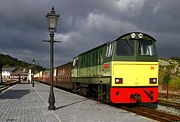 |
Ffestiniog Railway diesel hydraulic Vale of Ffestiniog stands at Porthmadog station on 21 October 2014, after having just propelled a rake of coaching stock into the new Welsh Highland Railway platform, in readiness for the 10:45 departure to Caernarfon. It was a generally cloudy morning, but a small hole appeared in the blanket of dark clouds after the loco and stock had left the sidings visible on the left of the picture. I hoped that the sun would stay out long enough for a decent picture once the train had backed into the platform. Luckily the train backed in without delay, and I had a few seconds worth of stunning light before the clouds blotted out the sun again. |
|
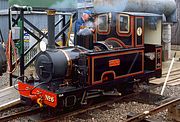 |
Gartell Light Railway 0-4-2T No.6 Mr. G receives some attention at Common Lane station on 3 June 2002. The loco was built especially for the line in 1998 by the North Dorset Locomotive Works. The Gartell Light Railway is a 2ft gauge line near Templecombe, the route of which mostly follows the course of the old Somerset & Dorset Railway. |
|
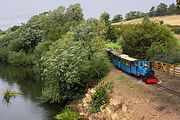 |
Alan Keef 2-6-0 Bunty runs alongside the River Till at Heatherslaw on 28 August 2018, as it approaches Heatherslaw station with the 12:30 departure from Etal. The locomotive was acquired by the Heatherslaw Light Railway in 2010, and is now the railway's principal motive power. |
|
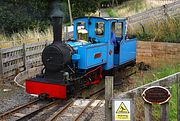 |
After being turned on the turntable at Etal station, the Heatherslaw Railway's 2-6-0 Bunty prepares to run round its train, prior to working the 13:30 service to Heatherslaw on 28 August 2018. The path in the background leads to the nearby ruined medieval Etal Castle. |
|
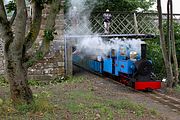 |
The Heatherslaw Railway's Alan Keef 2-6-0 Bunty leaves Heatherslaw station on 28 August 2018 with the 14:00 service to Etal. The bridge formerly carried a minor road linking the B6354 and B6353 roads, but it is now for pedestrian and cycles only. |
|
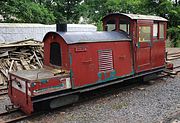 |
Looking slightly worse for wear, the Heatherslaw Railway's Bo-Bo diesel hydraulic loco Clive is pictured at Heatherslaw station on 28 August 2018. With peeling paintwork, and a fine assortment of lichen growing on the roof, it clearly hasn't received much attention on the last few years! |
|
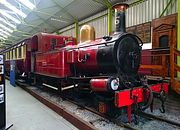 |
The Isle of Man Steam Railway's 2-4-0T No.6 Peveril, pictured inside the Port Erin Museum on 9 May 2017. She was built in 1875 by Beyer Peacock & Co, and worked on the line until 1960. There is still a possibility that one day it will be restored to working order, despite being out of use for over half a century. |
|
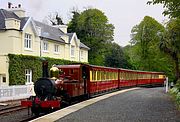 |
The Isle of Man Steam Railway's 2-4-0T No.8 Fenella arrives at Port Soderick station on 12 May 2017 with the 11:50 Douglas to Port Erin service. The train stopped briefly, but no passengers either joined or alighted. In fact apart from us two photographers, there seemed to be nobody in the vicinity at all. Fenella is now the only working loco of the original smaller engines. |
|
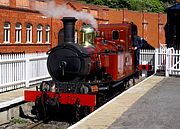 |
The Isle of Man Steam Railway's 2-4-0T No.12 Hutchinson, pictured at Douglas station on 8 May 2017, after arriving with the 14:00 service from Port Erin. The loco was built by Beyer, Peacock & Co, and was delivered to the island in 1908. |
|
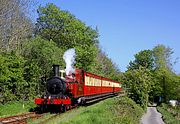 |
Late spring on the Isle of Man Steam Railway, and the fresh green foliage contrasts nicely with the loco's 'Indian Red' livery, as well as the red and cream of the coaches. 2-4-0T No.12 Hutchinson whistles as it approaches Santon on 8 May 2017 with the 15:50 Douglas to Port Erin service. |
|
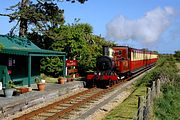 |
Ballabeg is one of the Isle of Man Steam Railway's smaller stations, and is little used. Being a request stop, trains often pass straight through, as is the case here, as Beyer, Peacock & Co. 2-4-0T No.12 Hutchinson steams through on 8 May 2017 with the 15:50 Douglas to Port Erin service. This station building is not the original, but was formerly a permanent way hut, with a canopy added in 1982. The station is in open countryside, some distance from the village of Ballabeg, on the A28 towards Castletown. |
|
 |
A pair of Isle of Man Steam Railway trains cross at Castletown on 9 May 2017. 2-4-0T No.12 Hutchinson arrives with the 11:50 Douglas to Port Erin service. The picture is taken from the 12:00 Port Erin to Douglas service, led by No.13 Kissack. |
|
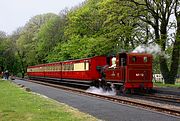 |
The Isle of Man Steam Railway's 2-4-0T No.12 Hutchinson waits at Castletown station on 12 May 2017 with the 10:00 Port Erin to Douglas. Already 15 minutes late, it would have to wait for a further seven minutes, as the 09:50 train from Douglas, hauled by No.13 Kissack, with which it was due to cross, was now running 22 minutes behind time. |
|
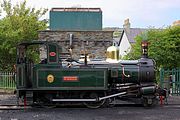 |
The Isle of Man Steam Railway's 2-4-0T No.13 Kissack stands next to the water tank at Port Erin, after arriving with the 09:50 service from Douglas on 9 May 2017. Kissack was the island's penultimate steam loco, arriving in 1910. |
|
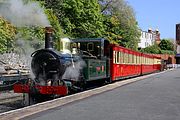 |
The Isle of Man Steam Railway's 2-4-0T No.13 Kissack stands at Douglas station on 9 May 2017, having just backed onto the stock that will form the 13:50 service to Port Erin. The dark Brunswick green livery is non-standard on the island. |
|
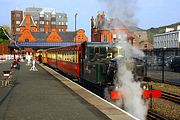 |
The Isle of Man Steam Railway's 2-4-0T No.13 Kissack stands at Douglas station on 11 May 2017, prior to working the unadvertised additional 19:00 'Pie and Mash' dining special to Port Erin. The weak low evening sunshine certainly highlights the red brickwork of the station building in the background. |
|
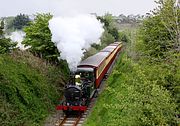 |
The Isle of Man Steam Railway's 2-4-0T No.13 Kissack passes Ballaquiggin (between Port Soderick and Santon) with the 09:50 Douglas to Port Erin service on 12 May 2017. Presumably it would have taken less time to raise steam on this occasion, as the loco was used the previous evening for a 'Pie and Mash' special, arriving back at Douglas after 22:40. |
|
 |
Running over 20 minutes late, the Isle of Man Steam Railway's 2-4-0T No.13 Kissack arrives at Castletown station on 12 May 2017 with the 09:50 Douglas to Port Erin service. The track in the foreground formerly served the station's goods shed. |
|
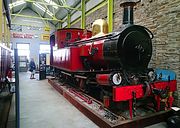 |
The Isle of Man Steam Railway's newest steam locomotive, 2-4-0T No.16 Mannin, pictured inside the Port Erin Museum on 9 May 2017. The loco was built in 1926, and was a more powerful version of the line's other 2-4-0s. She was withdrawn in 1964. |
|
 |
Isle of Man Steam Railway 0-4-0 diesel locomotive No.18 Ailsa stands at the head of a rake of coaching stock in Douglas station on the morning of 9 May 2017. Ailsa was built by the Hunslet Engine Co. in 1994 for use during the construction of the Channel Tunnel. However, it wasn't used, and instead was regauged, and used on the Jubilee Line extension of the London Underground. It then reverted to its original gauge and moved to the Isle of Man. The original intended use of the loco is reflected in its reduced height, which slightly restricts the driver's view. This explains the addition of cameras on arms attached to the corners of the loco. |
|
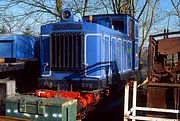 |
Eighteen inch gauge Hunslet articulated 0-4-4-0DM No.3 Carnegie stands in Alan Keef Ltd's yard at Lea (near Ross-on-Wye) on 2 March 2003. It is wearing the livery of the Bicton Woodland Railway, from where it had just been removed. The loco was built in 1954 for the Royal Arsenal Railway at Woolwich. |
|
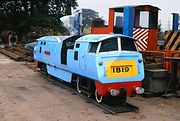 |
A different kind of 'Western'! The Southport Lakeside Miniature Railway's fifteen inch gauge diesel hydraulic Princess Anne stands amid the general clutter of Alan Keef Ltd's yard at Lea (near Ross-on-Wye) on 20 September 2003. This strikingly liveried, and reasonably convincing replica of the Western Region's Class 52 was built by Severn Lamb in 1971. |
|
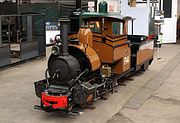 |
10¼ inch gauge Darjeeling & Himalayan Railway half size replica 0-4-0ST 44 is pictured inside the workshop of Alan Keef Ltd, at Lea (near Ross-on-Wye), during their 50th Anniversary Open Day on 24 September 2022. The loco was a built in 2014 for the Ferry Meadows Railway, Peterborough. |
|
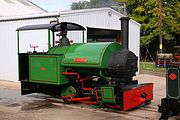 |
W.G.Bagnall 0-4-0ST 2133 Woto stands in Alan Keef's yard at Lea on 27 September 2022, during the 50th Anniversary Open Day. Although the site was open, this was almost an hour before the advertised opening time, which explains the lack of people. It got very crowded later on, making this kind of picture very difficult. |
|
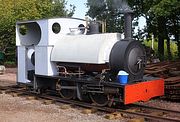 |
A historic moment for the Corris Railway's new build 0-4-2ST 10 Falcon on 24 September 2022, as it is steamed in public for the first time at Alan Keef's 50th Anniversary Open Day at Lea (near Ross-on-Wye). The loco, had only received its boiler certificate a few days earlier. In grey primer and without any buffers, it is pictured on the morning of the open day, just before the works plate was fitted. This will be the railway's second steam locomotive, and is based on one of the line's original locomotives, now in service on the Talyllyn Railway. |
|
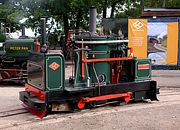 |
Alan Keef 0-4-0VBT 30 Taffy is pictured at the company's headquarters at Lea (near Ross-on-Wye), during their 50th Anniversary Open Day on 24 September 2022. This vertical boiler 'coffee pot' locomotive was built in 1990. |
|
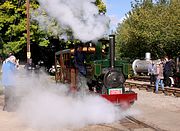 |
Kerr Stuart 0-4-0ST 4256 Peter Pan has plenty of steam to spare, as it completes the first of many short passenger trips, during Alan Keef's 50 than Anniversary Open Day at Lea on 24 September 2022. Note the Isle of Man Steam Railway boiler in the background. |
|
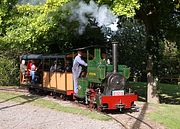 |
During Alan Keef's 50th Anniversary Open Day at Lea on 24 September 2022, Kerr Stuart 0-4-0ST 4256 Peter Pan was kept busy giving visitors short rides along the demonstration track. It is seen here passing underneath the trees on the third run. |
|
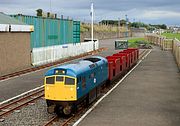 |
The real 25081 may have been scrapped in 1982, but it lives on in a smaller scale at the Kerr's Miniature Railway at Arbroath. The little petrol engined loco actually looks more like a Class 27, rather than a 25, which would certainly be more appropriate for Scotland. The 10¼ in gauge loco carries the name Elliot, after the small village to the west of the town. It is pictured here at the West Links Park station on 1 September 2018, during a rather quiet period. The line, which was some way from the centre of Arbroath, unfortunately closed in 2020. |
|
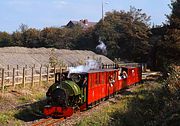 |
The fifteen inch gauge Kirklees Light Railway runs along the course of the Clayton West Branch, which was closed by British Rail in 1983. On 21 September 1997, 0-6-4ST Badger departs from Skelmanthorpe station with the 15:00 Clayton West to Shelley service. Badger was built especially for the line in 1991. |
|
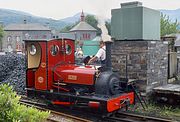 |
Hunslet 0-4-0ST 1 Elidir gets a drink at Gilfach Ddu station on the Llanberis Lake Railway prior to working its next train to Penllyn on 6 August 2002. Built in 1899 for the Dinorwic Quarry line, this little locomotive was originally named Red Damsel. When this picture was taken all passenger services started from Gilfach Ddu, however the following year an extension was opened to Llanberis with a new station not far from the Snowdon Mountain Railway's terminus. |
|
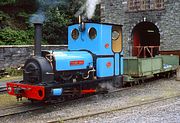 |
On 6 August 2002, Hunslet 0-4-0ST 2 Thomas Bach simmers gently in front of the 1870 built former quarry workshops at Gilfach Ddu station, on the Llanberis Lake Railway. This large range of buildings are now used to house the National Slate Museum. Thomas Bach was originally named Wild Aster when delivered to the Dinorwic Quarries in 1904. |
|
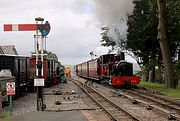 |
The Lynton & Barnstable Railway's Bagnall 4-4-0T 2819 Sir George Newnes arrives back at Woody Bay station on 16 September 2025 with the 12:30 train from Killington Lane. The loco was built in 1946 for the Tongaat Sugar Company of South Africa. The track workers in the background are preparing a new siding for a proposed carriage shed. |
|
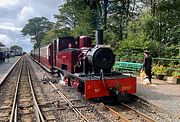 |
The Lynton & Barnstable Railway's Bagnall 4-4-0T 2819 Sir George Newnes stands at Woody Bay station on 16 September 2025, having just arrived with the 14:30 service from Killington Lane. Waiting on the platform is Henry the railway collecting dog, with his owner John Bond. They are hoping that the passengers getting off the train would put a few coins in the box on Henry's back. Railway collecting dogs were a feature of Waterloo station in the Victorian and Edwardian periods. |
|
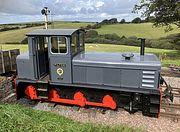 |
Looking immaculate after a recent fresh coat of paint, 1952 built Baguley Drewry 0-6-0 D2393 Pilton is pictured at Woody Bay station, on the Lynton & Barnstable Railway, on 16 September 2025. The loco spent its early working life in Australia. |
|
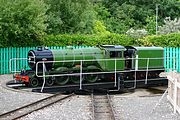 |
On 28 June 2008, Hudswell Clarke built 4-6-2 1932 Triton is turned on the turntable at Scalby Mills, on Scarborough's North Bay Railway. It had just arrived with the 13:00 train from Peasholm Park (with me on it!), and would soon be leaving with the returning 13:15 departure. Apart from the lack of exhaust and escaping steam, this loco hides its diesel engine very well, the most obvious clue being the filler on the smokebox, just behind the chimney. |
|
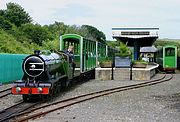 |
Hudswell Clarke built 4-6-2 1932 Triton pulls out of Scalby Mills station, on the Scarborough North Bay Railway, with 13:15 departure for Peasholm Park on 28 June 2008. Note the spare set of coaches stored in the siding on the right. |
|
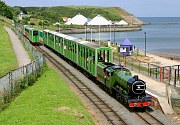 |
Hudswell Clarke built 4-6-2 1932 Triton leaves the disused Beach station on Scarborough's North Bay Railway with the 13:45 Scalby Mills to Peasholm Park service on 28 June 2008. It has just crossed sister loco 1933 Poseidon working the 13:45 Peasholm Park to Scalby Mills train. Beach station has a strange history, having been built in 1931 along with the rest of the line, it was not used by passengers until the 1980s, when during the construction of the Sea Life Centre (the white buildings in the background) it became a temporary terminus. However, it has now been closed again, and is used purely as a passing point when the fifteen minute interval service is in operation. |
|
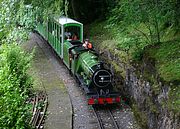 |
Steam outline, Hudswell Clarke built 4-6-2 diesel 1932 Triton runs through the trees alongside Northstead Manor Lake on the Scarborough North Bay Railway with the 15:00 Peasholm Park to Scalby Mills service on 28 June 2008. |
|
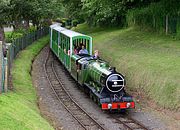 |
Hudswell Clarke built 4-6-2 1932 Triton emerges from the trees and approaches the disused Beach station on Scarborough's North Bay Railway with the 15:30 Peasholm Park to Scalby Mills service on 28 June 2008. The loop here extends a considerable distance towards Peasholm Park, Beach station being a little way around the corner. Note the dog leg trackwork! |
|
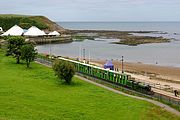 |
Hudswell Clarke built 4-6-2 1932 Triton waits at Beach station on Scarborough's North Bay Railway with the 16:15 Scalby Mills to Peasholm Park service on 28 June 2008. I'm not sure what the driver is picking up off the platform, but it has certainly startled the pigeon, which can be seen taking off in the lower right corner of the picture! |
|
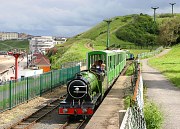 |
In a brief burst of sunshine before the dark clouds blotted out the sun once again, Hudswell Clarke built 4-6-2 1932 Triton leaves the disused Beach station on Scarborough's North Bay Railway with the 16:30 Peasholm Park to Scalby Mills service on 28 June 2008. It has just crossed sister loco 1933 Poseidon working the 16:30 Scalby Mills to Peasholm Park train, which can be seen departing under the footbridge. Beach station has only been used by passengers for a short period during the 1980s when it became the line's temporary northern terminus during construction of the Sea Life Centre. Note the chair lift striding over the hill. |
|
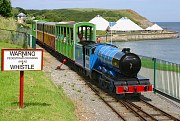 |
Hudswell Clarke built 4-6-2 1933 Poseidon arrives at the disused Beach station on Scarborough's North Bay Railway with the 13:30 Scalby Mills to Peasholm Park service on 28 June 2008. Scalby Mills signal box can be seen behind the train in the background, while the modern white buildings in the background belongs to the popular Sea Life Centre. The train is just entering the passing loop, where trains cross if traffic levels dictate that the fifteen minute two train service is in operation. |
|
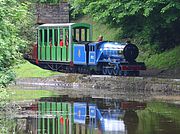 |
Hudswell Clarke built 4-6-2 1933 Poseidon is reflected in Northstead Manor Lake at Scarborough on the North Bay Miniature Railway, whilst working the 15:15 Peasholm Park to Scalby Mills service on 28 June 2008. Northstead Manor Gardens are a shadow of their former self, with the derelict open air theatre not having been used since 1987. Even this section of the lake has been fenced off and the few remaining hire boats now only operate on the southern section. |
|
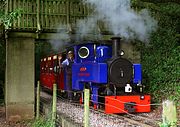 |
A cheery wave from the driver of Alan Keef 2-6-2T Lydia, as it emerges from the trees, and passes underneath the footbridge on the Perrygrove Railway on 16 July 2017. It is working the 13:50 Perrygrove to Oakiron service, on the line's ¾ mile route, which includes several sharp curves, and gradients as steep as 1 in 29. Although this picture looks like it was taken with flash, that is purely the effect of the train coming into the relatively bright surroundings, from the really dark wood on the other side of the bridge. |
|
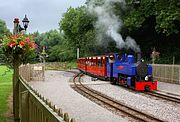 |
Plenty of well tended hanging baskets, but not a single passenger in sight! Alan Keef 2-6-2T Lydia enters Rookwood station on 16 July 2017 with the 15:10 Perrygrove to Oakiron service. The Perrygrove Railway opened in 1996, running through farmland and woods in a delightful setting on the edge of the Forest of Dean, near Coleford. The fifteen inch gauge line runs from Perrygrove Farm, through Rookwood and Heywood stations, to Oakiron station, so named as it is the site of a former iron ore mine shaft. Lydia was built specifically for the railway in 2008. |
|
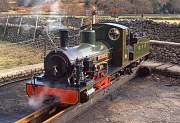 |
Ravenglass & Eskdale Railway 0-4-2 Bonnie Dundee on the turntable at Dalegarth on 8 February 1997. Bonnie Dundee has an interesting history, being built as a 0-4-0WT by Kerr, Stuart & Co in 1901, rebuilt as a 0-4-2T and re-gauged in 1981, and then finally converted into a 0-4-2 tender loco in 1996. A fleeting patch of winter sunshine came just at the right moment for this picture. |
|
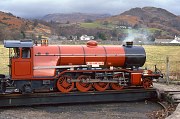 |
Ravenglass & Eskdale Railway 2-8-2 River Mite stands on the turntable at Dalegarth on 8 February 1997, with the houses of Boot and the cloud shrouded Fells in the background. River Mite was built Clarkson's of York in 1966, and gained some notoriety when it was hauled from York to the railway by traction engine! The red livery is based on that of the Furness Railway. |
|
 |
Ravenglass & Eskdale Railway 2-8-2 River Mite arrives at Fisherground station on 26 May 2018 with the 15:30 Ravenglass to Dalegarth service. This is one of the line's request stops, mainly used by visitors to the nearby campsite. The water tower is no longer used. |
|
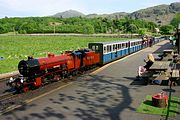 |
Ravenglass & Eskdale Railway 2-8-2 River Mite stands in the sunshine at Dalegarth station on 26 May 2018, prior to working the 16:30 service to Ravenglass. The mountain in the background is Harter Fell, a 2128 ft high peak between the valleys of the River Esk and River Duddon, and not far from the notoriously treacherous Hardknortt Pass. |
|
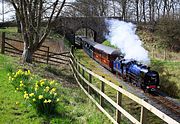 |
Springtime on the Ravenglass & Eskdale Railway. The line's newest acquisition, Krauss & Co 4-6-2 8457 approaches Muncaster Mill on 14 April 2018 with the 13:50 Ravenglass to Dalegarth service. The loco was built in 1927 for the Ibero-American Exposition of 1929, held in Seville. After sporadic use until 1932 it was put into store, and amazingly stayed unused until the 1960s. After being purchased for an abortive railway project in Barcelona, it was eventually acquired by the Ravenglass line in 2015, funded by a 'Train from Spain' appeal. After restoration the loco entered service on 17 March 2018, but will be officially unveiled on 5 May, when it will be receive the name Whillan Beck. |
|
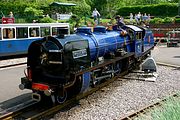 |
Krauss & Co 4-6-2 Whillan Beck comes off the turntable at Ravenglass on 26 May 2018, after bringing in the 12:50 service from Dalegarth. I had photographed this loco just over a month earlier, but that was before it had received its name. This is the Ravenglass & Eskdale Railway's most recent addition, entering service in March 2018. |
|
 |
A brief patch of winter sunshine shows off the red livery of the Ravenglass & Eskdale Railway's diesel loco Lady Wakefield at Dalegarth on 8 February 1997. The loco was built by the railway in 1980 and named after the wife of the then chairman of the railway. It is powered by a Perkins diesel engine. The loco has subsequently be painted DRS blue to match the mainline diesel locos it almost meets at Ravenglass! |
|
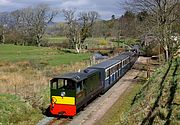 |
The Ravenglass & Eskdale Railway's diesel loco Lady Wakefield passes Muncaster Mill station in superb light on 14 April 2018 with the 13:30 Dalegarth to Ravenglass service. Note the disused siding to the right of the platform. The River Mite, after which one of the line's steam locomotives is named, can be seen above the first coach. |
|
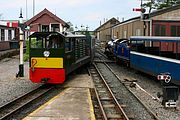 |
Diesel meets steam on the Ravenglass & Eskdale Railway on 26 May 2018. Lady Wakefield arrives at Ravenglass station with the 13:30 service from Dalegarth, while Whillan Beck gets ready to work the 14:25 Ravenglass to Dalegarth service. |
|
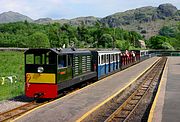 |
The Ravenglass & Eskdale Railway's diesel loco Lady Wakefield stands at Dalegarth station on 26 May 2018, prior to working the 15:50 service to Ravenglass. The original terminus of the line when the railway was a 3ft gauge line was at Boot, but when it was converted to 15 inch gauge in the 1920s, this station was constructed next to the valley road, on the course of the old Gill Force haematite drift mine branch. |
|
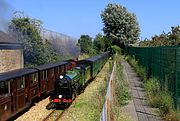 |
A meeting of Romney, Hythe & Dymchurch Railway trains at Palmarsh on 18 July 2021. 4-6-2 No.1 Green Goddess has just started out in its journey with the 14:35 Hythe to Romney service, and is passing 4-6-2 No.9 Winston Churchill, which is working the 14:10 New Romney to Hythe train. Not one single person used the footpath on the right while I was there. |
|
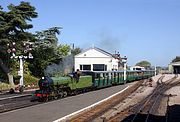 |
Romney, Hythe & Dymchurch Railway 4-6-2 No.1 Green Goddess arrives at New Romney under a clear blue sky on 29 August 2024 with the 11:15 Hythe to Dungeness service, passing a fine selection of lower quadrant semaphore signals. |
|
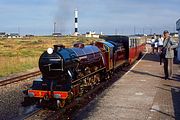 |
1927 built Davey Paxman & Co 4-8-2 No.5 Hercules stands at the Romney, Hythe & Dymchurch Railway's Dungeness station on 25 July 1998, with the distinctive 1961 built lighthouse in the background. Designed by Henry Greenly, Hercules was one of two locomotives with this unusual (for Britain) wheel arrangement ordered for the line, the other being No.6 Samson. Hercules was heavily modified during the Second World War for use on the line's armoured train, but luckily did not get attacked by the Luftwaffe! Incidentally, despite appearances I don't think the man on the right is the former pop impresario Jonathan King! |
|
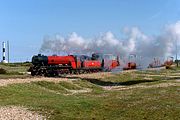 |
Romney, Hythe & Dymchurch Railway 4-8-2 No.6 Samson leaves Dungeness station on 15 April 1989 with the 15:25 service to Hythe. The loco was built by Davey Paxman & Co, and arrived in Kent in July 1927. For most of its life the loco has been in a much less bright livery than seen here. Lined black was the original livery, but the loco was repainted into this red colour scheme for its sojourn at the 1984 Liverpool Garden Festival. Shortly after this picture was taken, it was again repainted, this time into dark Prussian blue, a livery which it still retains. |
|
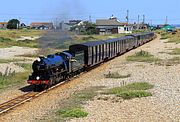 |
Romney, Hythe & Dymchurch Railway 4-8-2 No.6 Samson approaches Dungeness on 18 July 2021 with the 10:25 New Romney to Dungeness service. The large expanse of shingle, with patches of grass and coastal plants, along with the scattered (often timber) bungalows makes the area unlike anywhere else in Britain. |
|
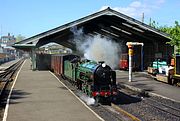 |
Romney, Hythe & Dymchurch Railway 4-6-2 No.7 Typhoon prepares to leave New Romney station on 3 June 2013 with the first train of the day, the 09:35 to Hythe. Unfortunately this locomotive was to suffer a failure later in the day, causing it to be removed from service. |
|
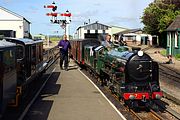 |
Running at little more than walking speed, an ailing No.7 Typhoon limps into New Romney station, on the Romney, Hythe & Dymchurch Railway, on 3 June 2013 with the late running 14:30 Hythe to Dungeness service. It would be removed from the train and replaced by 4-6-2 No.9 Winston Churchill, which itself had been removed from the 14:30 Dungeness to Hythe train, which can be seen waiting to depart on the left. One of the line's diesel locomotives, No.12 John Southland had been commandeered from the weedkilling train to work this train. It's smiling driver has just acquired the token from the driver of Typhoon. Various members of the loco depot staff could be seen staring at Typhoon's motion as it pulled slowly into the station. |
|
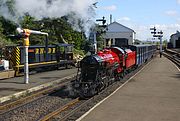 |
Romney, Hythe & Dymchurch Railway 4-6-2 No.9 Winston Churchill brings the empty stock of the 10:00 departure for Dungeness into New Romney station on 3 June 2013, passing one of the line's diesel locos, No.12 John Southland, which is parked in the siding with the weedkilling train. |
|
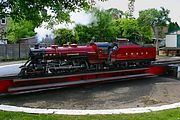 |
Romney, Hythe & Dymchurch Railway 4-6-2 No.9 Winston Churchill is turned on the turntable at Hythe on 3 June 2013, after arriving with the 11:00 train from Dungeness. After taking water, it would return with the 12:30 service to Dungeness. |
|
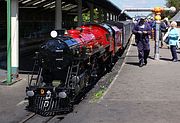 |
Romney, Hythe & Dymchurch Railway 4-6-2 No.9 Winston Churchill takes water at New Romney on 3 June 2013, whilst working the 12:30 Hythe to Dungeness service. Note the very unusual lagging on the water column! |
|
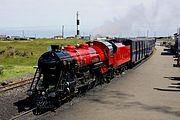 |
Yorkshire Engine Company 4-6-2 No.9 Winston Churchill waits at Dungeness station on 3 June 2013, at the southern extremity of the Romney, Hythe & Dymchurch railway. It had just arrived with the 12:30 train from Hythe, and would soon be leaving with the 14:30 return service. |
|
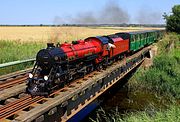 |
Romney, Hythe & Dymchurch Railway 4-6-2 No.9 Winston Churchill crosses the steel and timber bridge at St Mary's Bay on 18 July 2021 with the 11:00 Hythe to Dungeness non-stop service. This is one of several rather basic looking bridges on the line, this one crossing the rather unfortunately named New Sewer, not a sewer in the normal sense, but an artificial channel cut to drain a large area of the Romney Marsh. |
|
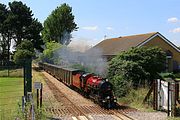 |
Romney, Hythe & Dymchurch Railway 4-6-2 No.9 Winston Churchill passes Palmarsh on 9 July 2021 with the 14:10 New Romney to Hythe service. Note the use of sections of old rail to form a 'cattle grid', to prevent animals straying onto the line from the public footpath crossing. |
|
 |
Romney, Hythe & Dymchurch Railway 4-6-2 No.11 Black Prince, pictured on the turntable at Hythe on 29 August 2024, just prior to it working the 09:50 train to Dungeness. The loco was built by Friedrich Krupp GmbH, at Essen, Germany, in 1937. |
|
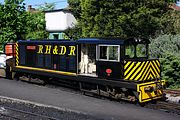 |
The Romney, Hythe & Dymchurch Railway has two mainline diesel locomotives, in addition to a number of small shunters. The 1983 TMA Engineering built Bo-Bo No.12 John Southland is pictured at New Romney on 3 June 2013, with the open cab door giving a good view of the interior. The loco is powered by a six cylinder Perkins diesel engine, developing 112hp. |
|
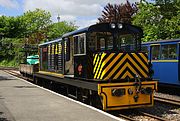 |
Romney, Hythe & Dymchurch Railway Bo-Bo diesel locomotive No.12 John Southland stands in Hythe station on 3 June 2013, having just brought the weedkilling train (spray equipment and tank on an adapted open wagon!) in from New Romney. |
|
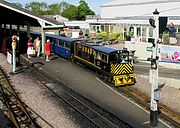 |
Romney, Hythe & Dymchurch Railway Bo-Bo diesel loco No.12 John Southland leaves New Romney station on 3 June 2013 with the late running 16:00 Hythe to Romney Sands service. The delay was caused by the earlier partial failure of No.7 Typhoon. However, some spirited running had seen the northbound train's 20 minutes late departure, reduced to just 7 minutes on the return. |
|
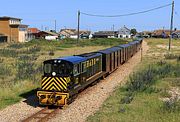 |
The Romney, Hythe & Dymchurch Railway's Bo-Bo diesel No.12 J.B. Snell approaches Dungeness on 18 July 2021 with the 09:43 Romney Sands to Dungeness service. It is just approaching the Dungeness Road level crossing, and Battery Road level crossing can just be seen in the background. This marks the site of the former Pilot Inn station, which closed in 1983. |
|
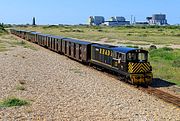 |
The unmistakable landscape of Dungeness, the largest expanse of shingle in Europe. The Romney, Hythe & Dymchurch Railway's Bo-Bo diesel No.12 J.B. Snell crosses the parched landscape on 18 July 2021 with the 10:20 Dungeness to Hythe service. Two other distinctive features of the area dominate the background. The disused 1904 lighthouse, which was replaced by a striking modern concrete structure in 1961, and Dungeness A and B nuclear power stations |
|
 |
1938 Simplex diesel mechanical 0-4-0 PW1 is the Romney, Hythe & Dymchurch Railway's oldest non steam locomotive. It is used for shunting at New Romney, and is pictured there during a break in its morning's work on 3 June 2013. In addition to this vintage loco, the RH&DR also has two other petrol shunters. |
|
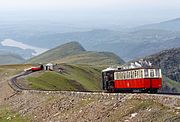 |
Snowdon Mountain Railway 0-4-0RT 6 Padarn descends from Snowdon summit on 6 August 2002, as 0-4-0 diesel locomotive 12 George waits at Clogwyn station with an ascending train. The railway's original five steam locomotives were built in 1895-6. No.6 Padarn was the first of a small batch of new locomotives built in the 1920s. Although a slightly misty day, Llyn Padarn can clearly be seen in the background. |
|
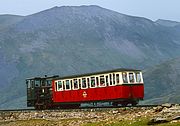 |
Snowdon Mountain Railway 0-4-0 diesel locomotive 12 George pushes its single coach up the mountain on 6 August 2002. Built by the Hunslet Engine Co, Leeds in 1992, this is the last of a batch of four similar locos that were added to the resident steam fleet from 1986 onwards. It is powered by a 12 litre 320 Horsepower (238 kW) six cylinder turbocharged Rolls Royce engine. |
|
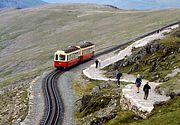 |
As walkers negotiate the long winding path from Llanberis to the summit of Snowdon on 6 August 2002, some less hardy people take the easy option, travelling to the summit on the Snowdon Mountain Railway's diesel electric railcars 23 & 21. The railway acquired three of these railcars in 1995 from HPE Tredegar Ltd, but control problems led to them being withdrawn by 2003, and ultimately scrapped. Because each railcar only had one set of pinions, they could not work singly. Incidentally, Wikipedia states that No.21 had been withdrawn by 2001. This is clearly wrong, as No.21 is definitely the rear vehicle of this pair. |
|
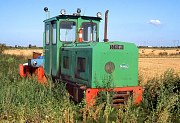 |
Schöma 0-4-0 86hp 5129 and its slave unit stand amid the weeds near Red House Farm, Swinefleet on 1 September 2002, shortly after the 3 ft gauge peat railway ceased operations. This view is looking towards Goole, and Drax Power Station can clearly be seen on the horizon. This loco was one of a pair that were used on the line its later years, and they were considerably more powerful than anything used previously. The lines stretched for miles onto Goole and Swinefleet Moors, with both permanent and semi-permanent sections of track laid to reach the various peat cutting areas. The site, which had been operated by Fisons, Levingtons, and finally Scotts, has now been taken over by English Nature. |
|
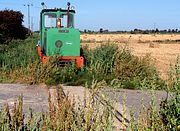 |
Schöma 0-4-0 5129 is pictured in its final resting place on the Swinefleet Peat Railway, next to the access road to Red House Farm on 1 September 2002. Judging by the encroaching vegetation, it clearly hadn't moved for a while. |
|
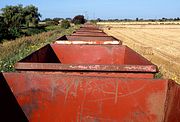 |
When the 3ft gauge Swinefleet Peat Railway ceased operations in July 2000, the line's Schöma 0-4-0 diesel locomotive 5129, and a line wagons were left abandoned either side of the concrete access road to Red House Farm. This slightly unusual viewpoint taken on 1 September 2002 shows the wagons, with 5129 visible at the far end of the rake. The road to the farm crosses the stubble fields on the right, and accesses the farm via a bridge over the Swinefleet Warping Drain, a ditch which can be seen paralleling the line on the left. |
|
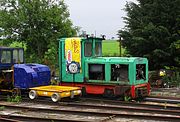 |
Schöma 0-4-0 5129 stands forlornly amidst other assorted narrow gauge equipment in the privately owned station yard at Hardingham, next to the Mid Norfolk Railway. This 1990 built locomotive was formerly used at the Swinefleet and Hatfield Moors peat railways, which closed in 2000 and 2006 respectively. A nice reuse of a Thomas the Tank Engine banner! The picture was taken from the 13:45 Wymondham Abbey to Dereham DMU on 29 May 2014. |
|
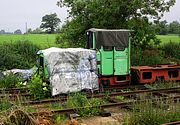 |
Formerly of the Swinefleet and Hatfield Moors peat railways, Schöma 0-4-0 5220 stands amongst the weeds in the yard of Hardingham station next to the Mid Norfolk Railway on 29 May 2014. Photo taken from the passing 13:45 Wymondham Abbey to Dereham DMU. Whilst in use at Hatfield the loco was named The Thomas Buck. The mark left by the removal of the nameplate can just be seen above the radiator. The name seems to have been transferred to sister loco 5130, which has been preserved as a static exhibit at the Hatfield Moors works. |
|
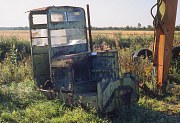 |
Motor Rail 0-4-0 40hp 40s302 stands abandoned in the grass at Bank Top, on the Swinefleet Peat Railway on 1 September 2002. Surrounded by more discarded equipment, and on the opposite of the rough track to the surviving railway line, this loco has obviously seen better days! The 3 ft gauge line had just recently closed, although this particular loco had been out of use since 1996. Like most of the locos used on the line it had been modified throughout its life, the cab in particular been altered. |
|
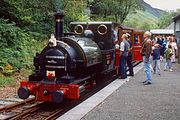 |
Fletcher Jennings & Co 0-4-2ST 1 Talyllyn stands at Abergynolwyn station on 8 August 2002, having just arrived with the 12:20 Tywyn Wharf to Nant Gwernol service. This was the Talyllyn Railway's first locomotive, having been delivered to the line on 24 September 1864. |
|
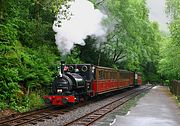 |
Fletcher Jennings & Co 0-4-2ST 1 Talyllyn arrives at a rain soaked Abergynolwyn station on 3 June 2012 with the 10:30 service from Tywyn Wharf to Nant Gwernol. This was the Talyllyn Railway's first locomotive, which was originally constructed as a 0-4-0ST. Poor stability soon led to the addition of trailing wheels. A cab was also added (very necessary in weather like this!). |
|
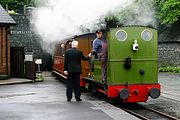 |
Token exchange at Tywyn Wharf, on the Talylln Railway. Fletcher Jennings & Co 0-4-0WT 2 Dolgoch arrives with the 11:35 service from Nant Gwernol on 20 May 2006. This is one of the line's two original locomotives, and the only one that was operational when the preservation society took over in 1951. |
|
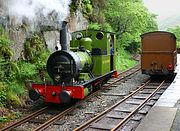 |
After having arrived at Nant Gwernol with the 13:55 train from Tywyn Wharf, 0-4-0WT 2 Dolgoch runs round its train on 20 May 2006, before heading back down the valley with the 15:00 departure. This is the eastern extremity of the Talyllyn Railway. It opened to passengers in 1976, having only been served by slate trains in pre-preservation days. |
|
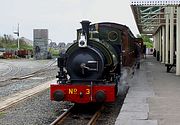 |
The Talyllyn Railway's 0-4-2ST 3 Sir Haydn waits at Tywyn Wharf station on 30 April 2022, prior to departure with the 14:55 train for Abergynolwyn. In the background is the water tower, and the sharply curved sidings that were formerly used for slate transshipment. |
|
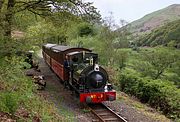 |
Talyllyn Railway 0-4-2ST 3 Sir Haydn arrives at Quarry Siding on 6 May 2024 with the 12:20 Tywyn Wharf to Nant Gwernol service. Note the bluebells growing right next the track in the foreground. The 1013 feet high peak of Foel Wyllt dominates the background, with the valley of the Afon Fathew visible through the bushes on the right. |
|
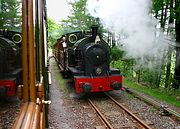 |
Talyllyn reflection. Former Corris Railway 1921 built Kerr Stuart & Co. 0-4-2ST No.4 Edward Thomas is reflected in the windows of my train (hauled by No. 2 Dolgoch), as the two trains cross at Quarry Sidings on 20 May 2006. Edward Thomas is working the 15:00 Tywyn Wharf to Nant Gwernol, whilst I am on board the 15:00 Nant Gwernol to Tywyn Wharf service. |
|
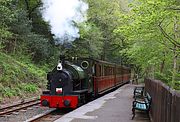 |
Kerr Stuart 0-4-2ST 4 Edward Thomas arrives at Abergynolwyn station on 30 April 2022 with the 15:30 train from Tywyn Wharf. The loco was built in 1921 for the Corris Railway, working on that line until 1947. The Corris Railway closed in 1948, and the loco was acquired by the Talylln Railway in 1951, along with the Corris's other loco, 0-4-2ST 3 (later named Sir Haydn). |
|
 |
Talyllyn Railway Ruston 0-4-0 diesel No.5 (formerly named Midlander) waits in the rain at Abergynolwyn station on 3 June 2012. It had just brought a party of young volunteers up from Tywyn, and is now waiting to return to Pendre. Built in 1941, this locomotive was acquired by the railway in 1957 and proved itself to be extremely useful in the early preservation era. |
|
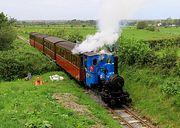 |
Talyllyn Railway 0-4-0WT 6 Douglas passes Cynfal on 13 May 2022 with the 11:45 Tywyn Wharf to Nant Gwernol service. The loco was repainted into this striking blue colour scheme in 2018 to mark the centenary of the Royal Air Force, as well as the centenary of the loco itself. There cannot be many locomotives that carry the RAF roundel as a logo! |
|
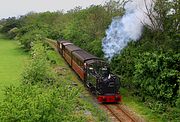 |
Talyllyn Railway 0-4-2T 7 Tom Rolt passes Ty Mawr on 13 May 2022 with the 10:00 Tywyn Wharf to Nant Gwernol service. This loco was rebuilt from a former Irish 3ft gauge Bord na Móna locomotive. It is named after one of the Talyllyn Railway's founder members, the famous transport historian and writer, L. T. C. Rolt. |
|
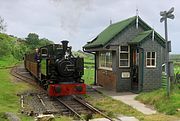 |
Talyllyn Railway 0-4-2T 7 Tom Rolt passes Brynglas Ground Frame on 13 May 2022 with the 13:30 Tywyn Wharf to Nant Gwernol service, after waiting for a few minutes in the loop for the 12:50 Nant Gwernol to Tywyn Wharf train. |
|
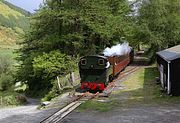 |
Talyllyn Railway 0-4-2T 7 Tom Rolt leaves Quarry Siding on 6 May 2024 with the 11:35 Nant Gwernol to Tywyn Wharf service. A new carriage shed now occupies the site of he old quarry, which formerly supplied ballast for the railway. The rough track leading from the farm occupation crossing in the foreground, descends very steeply to the Tywyn to Abergynolwyn road, which can just be glimpsed on the left. |
|
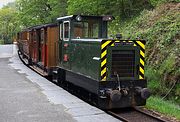 |
1983 built Baguley-Drewry Ltd 4wDH No.11 Trecwn stands at Abergynolwyn station on 30 April 2022, whilst employed on shuttle trains to Nant Gwernol. The Talyllyn Railway acquired three of these locos from RNAD Trecwn in 2008. One was used for spares, the other, No.12 St. Cadfan is out of sight on the other end of this train. The locos had to be regauged from 2' 6" after they arrived from Trecwn. |
|
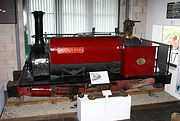 |
Hunslet 0-4-0ST 541 Rough Pup, pictured inside the Narrow Gauge Museum at Tywyn Wharf on 3 June 2012. The loco was built in 1891 for the Dinorwic Quarry railway. It spent its entire working life there, being withdrawn in 1960. |
|
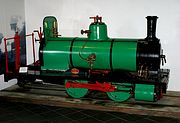 |
Kerr Stuart 0-4-0WT 721, pictured inside the Narrow Gauge Museum at Tywyn Wharf on 3 June 2012. This diminutive locomotive was built in 1901 for the Dundee Gas Works. It looks a little unbalanced, as if it should really be a 0-4-2WT! |
|
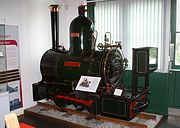 |
With a steam dome almost the same diameter as its boiler, 18 inch gauge, 1887 built Beyer, Peacock & Company 0-4-0WT 2817 Dot is pictured inside the Narrow Gauge Museum at Tywyn Wharf on 3 June 2012. |
|
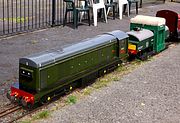 |
The Doncaster & District Model Engineering Society's 7¼ inch gauge Class 20 20173 Enya, pictured at the Thorne Memorial Park Miniature Railway on 30 June 2019. This battery powered locomotive is fitted with digital sound. Note the model of a diesel brake tender acting as a driver's seat. |
|
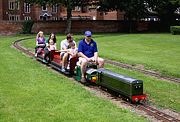 |
Thorne Memorial Park Miniature Railway 7¼ inch gauge Class 20 20173 Enya traverses the 600 foot outer loop through the neatly mown grass of the park on 30 June 2019. The outer loop is dual gauge (5 inch and 7¼ inch), while the more recent inner loop is 7¼ inch gauge only. |
|
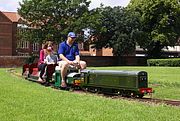 |
Thorne Memorial Park Miniature Railway 7¼ inch gauge Class 20 20173 Enya does another circuit of the park on 30 June 2019. Just visible in the background on the right is the bridge that carries the main road over the Stainforth & Keadby Canal. |
|
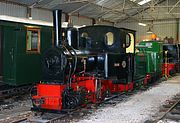 |
0-4-0WT Justine rests inside the shed of the two foot gauge Toddington Narrow Gauge Railway on 25 April 2011. She was built by Arnold Jung of Germany in 1906 and used in a wide range of industrial applications on the continent, before coming to England in 1975. Behind her is 1953 built Ruston & Hornsby 0-4-0 diesel mechanical shunter 354028, with the partially dismantled 1936 built 181820 (also by Ruston & Hornsby) at the rear of the shed. |
|
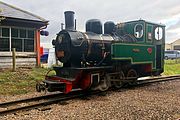 |
The Toddington Narrow Gauge Railway's 0-6-0T Tourska stands next to the former Honeybourne North Loop Signal Box (now a museum used by the Gloucestershire Warwickshire Railway) at Toddington on 20 October 2019. The loco was built in 1957 by Chrzanow, Poland. |
|
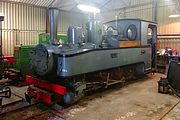 |
0-8-0T 1091 stands inside the Toddington Narrow Gauge Railway's loco shed on 20 October 2019. The loco was built in 1918 by Henschel & Son of Cassel, Germany. The loco arrived in Gloucestershire in 1985, having been bought from the Naklo Sugar Factory in Poland. |
|
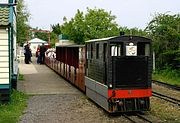 |
If you think a Class 66 is a 'Shed', then what about this! The Wells and Walsingham Railway's diesel loco No.2 Weasel waits at Wells-on-Sea station on 31 May 2014, prior to working the 12:00 service to Walsingham. Weasel is a 0-6-0 diesel hydraulic built by Alan Keef in 1985. It is powered by a 2 litre Perkins engine. |
|
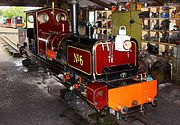 |
The Wells and Walsingham Railway's 2-6-0 + 0-6-2 Garratt locomotive No.6 Norfolk Heroine is pictured inside the shed at Wells-on-Sea on 31 May 2014, while outside one of the line's diesel locos, No.2 Weasel can be seen preparing to work the 10:30 service to Walsingham. Norfolk Heroine is named after the First World War nurse Edith Cavell, who was shot by the Germans in 1915. Built as recently as 2010, the loco is one of two of these unusual and powerful articulated locomotives at work on this 10¼in gauge line. |
|
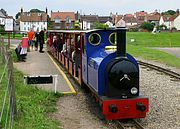 |
With a background of typical Norfolk pantiled cottages, 0-6-0 steam outline diesel loco Howard waits at Wells Harbour station on 31 May 2014, prior to taking another load of holidaymakers along the mile long Wells Harbour Railway to Pinewoods. Howard was built in 2005 by Alan Keef. |
|
 |
The 10¼in gauge Wells Harbour Railway runs for approximately a mile alongside Beach Road, from Wells-on-Sea to the holiday camp and lifeboat station on the North Sea coast, which due to centuries of silting up, is now a considerable distance from the town. The line's 0-6-0 steam outline diesel loco Howard is pictured setting off from Wells Harbour station on 31 May 2014 with another trip to Pinewoods. |
|
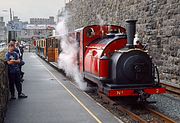 |
The world's oldest regularly worked steam locomotive, the Ffestiniog Railway's 1864 built 0-4-0ST 2 Prince waits to leave Caernarfon station on the Welsh Highland Railway (Caernarfon) with the 17:00 service to Waunfawr on 7 August 2002. The thirteenth century Caernarfon Castle can be seen in the background. |
|
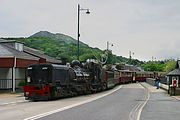 |
Welsh Highland Railway ex South African Garratt No. 87 weaves across Porthmadog High Street, as it arrives at the Ffestiniog Railway's station with the 12:55 service from Caernarfon on 2 June 2012. As well as the impressive scenery further up the line, this long level crossing with the track actually running along the road for a short distance is one of the highlights of the line. |
|
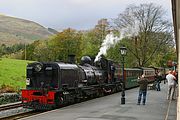 |
Welsh Highland Railway Garratt 87 pulls into Beddgelert station on 21 October 2014 with the 10:00 Caernarfon to Porthmadog service. Viewed from the 10:45 Porthmadog to Caernarfon train. Despite the fact that the station would presumably increase tourism, there was much local opposition to the reopening of Beddgelert station. |
|
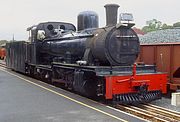 |
The rusting hulk of former South African Narrow Gauge Railways NG15 Class 2-8-2 133 awaits restoration at Dinas on 7 August 2002. The Welsh Highland Railway (Caernarfon) acquired this 1953 Belgium built loco in 1998. Note the fully loaded ballast wagons in the background for use on the extension to Rhyd Ddu. |
|
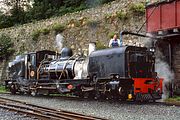 |
If you want to see Beyer-Garratts in the UK go to North Wales. The Welsh Highland Railway has a selection of these impressive beasts. On 7 August 2002 Beyer Peacock's final steam locomotive - the 1968 built NGG16 Class 2-6-2+2-6-2 143 takes water at Caernarfon. |
|
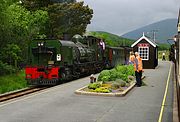 |
A pair of ex South African Railways Garratts crossing on the Welsh Highland Railway on 1 June 2012. Beyer Peacock 143 arrives at Rhyd Ddu with the 11:15 Caernarfon to Porthmadog service. The picture is taken from onboard the 11:00 Porthmadog to Caernarfon, headed by Cockerill built No. 87, which can just be seen taking water. |
|
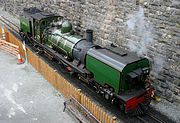 |
Welsh Highland Railway NGG16 Class 2-6-2+2-6-2 143 stands at Caernarfon on 21 October 2014. Just a few minutes later, whilst the loco was taking water, this pleasant autumn day was briefly transformed into monsoon conditions! |
|
 |
This shows just how quickly the weather can change in Wales. Shortly after taking a picture of Welsh Highland Railway NGG16 Class 2-6-2+2-6-2 143 at Caernarfon on 21 October 2014, this torrential downpour occurred while the loco was taking water. This unusual viewpoint, looking down from a footpath that runs above the line, is in marked contrast to the same loco (in a different livery), at the same spot twelve years earlier. |
|
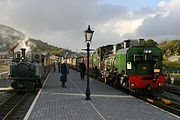 |
A narrow gauge motive power contrast at Porthmadog on 21 October 2014. On the right, Beyer Garrett NGG16 Class 2-6-2+2-6-2 143 has just arrived with the 14:15 Welsh Highland Railway service from Caernarfon, while on the left Ffestiniog Railway Fairlie 0-4-4-0T 12 David Lloyd George has just moved forward in readiness to shunt the empty stock off the 15:05 train from Blaenau Ffestiniog. This picture gives a good view of the new £1m platform, which allows both Ffestiniog and Welsh Highland trains to occupy the station at the same time. |
|
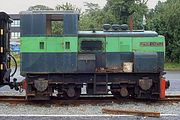 |
1954 built Hibberd 0-4-0 diesel loco Upnor Castle is pictured at Dinas on the Welsh Highland Railway (Caernarfon) on 7 August 2002. The loco had previously spent nearly two decades on the nearby Ffestiniog Railway. This side view clearly shows the chain drive and the large sand boxes. |
|
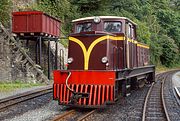 |
1967 built Funkey (the manufacturer not my adjective!) B-B diesel locomotive Castell Caernarfon ambles past the water tower at Caernarfon station on the Welsh Highland Railway (Caernarfon) on 7 August 2002. The loco, which originally worked on the Port Elizabeth line in South Africa, is one of the most powerful narrow gauge diesels in the UK by virtue of its 335hp turbocharged Cummins engine. The yellow stripes had only just been added when this picture was taken. |
|
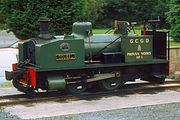 |
The Welshpool & Llanfair Railway's 1946 built Andrew Barclay 0-4-0T 1 Dougal is certainly an unusual locomotive. Especially built to negotiate the restricted height tunnels in the Glasgow City Gas Department's Provan Gas Works, this diminutive locomotive is dwarfed even by other narrow gauge stock. Note also the short wheelbase (to traverse tight radius curves) and consequent lengthy front and rear overhang. It is pictured here at Llanfair Caereinion on 4 August 2002. |
|
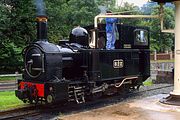 |
Welshpool & Llanfair Railway 0-6-0T 822 The Earl has its water tanks topped up at Welshpool on 4 August 2002. Built by Beyer Peacock in 1903, 822 is one of the line's original two locomotives, the other being 823 Countess. Note the large cast number plate, dating from its days as part of the Great Western Railway fleet. |
|
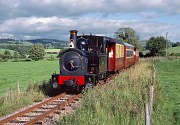 |
Welshpool & Llanfair Railway 0-6-0T 2 The Countess passes Dolarddyn with the final Welshpool to Llanfair train of the day on 2 August 1987. She is one of the original locomotives built for the line in 1903 by Beyer Peacock. The other loco built at the same time is 1 The Earl. Unlike many Welsh narrow gauge railways built to exploit the slate industry, this line was built to serve a purely agricultural area, and not surprisingly never made a profit. |
|
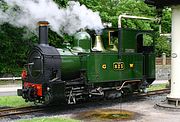 |
Welshpool & Llanfair Railway 0-6-0T 823 Countess waits beneath the water tower at Welshpool on 4 June 2012. prior to working the 12:45 train to Llanfair Caereinion. Ironically I had photographed the line's other original locomotive, 822 The Earl at the same location almost a decade previously. |